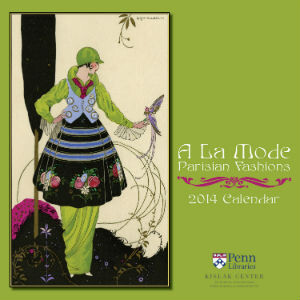Penn Libraries 2014 Calendar Features Parisian Fashions
Today’s fashion magazines are mass-produced, but some rare, earlier magazines of high fashion became collector’s items partly for their artwork.
A complete set of the French publication Journal des dames et des modes is part of the University of Pennsylvania Libraries Kislak Center for Special Collections. Thirteen of the magazine’s images are featured in the Libraries 2014 calendar.
“When we look at our collections, certain things come to mind for visual, instant appeal,” says Andrea Gottschalk, of the Kislak Center and the calendar designer. “This journal and its illustrations are stunningly graphic.”
Gottschalk worked along with Lynne Farrington, curator of printed books in the Rare Book and Manuscript Library, to select the images for the January 2014-January 2015 13-month calendar.
“One of the fun things about using these illustrations,” says Farrington, “is that we could do a calendar and find things that would immediately work for each month of the year, with clothing that could relate to summer, winter, fall and spring.”
For example, the calendar shows an image of a woman in a bathing suit at the beach for July. And the December image features a woman on a ski slope wearing a wool outfit trimmed with fur.
Published between 1912 and 1914, the magazine used top commercial artists, including Umberto Brunelleschi to create the illustrations of high fashion clothes for the elite in Paris.
“It would have been a very expensive subscription to have,” explains Farrington. “It was coming out three times a month, with lots of the images being drawn by premier artists of the period, who I presume would have been well-paid for their efforts.”
The hand-drawn illustrations were then engraved on copper plates and printed on handmade paper and then hand-colored using stencils in a method called pochoir.
“There must have been a whole group of women coloring plates, and each one would do a different stencil,” Farrington says.
She calls it a “high-end production” because of the amount of handwork involved in creating the journal. Sometimes, even gold and silver were used in coloring the images.
And, unlike most magazines, the pages of the journal were loose broadsides and were meant to be keepsakes.
“It wasn’t some kind of ephemeral thing like a magazine today that you would throw out when you were done reading through it,” Farrington says. “There was the idea that there was a long standing value to these fashion plates and to this publication beyond the time of their publication.”
The magazine was published for just over two years, ending its run in 1914.
The Penn Libraries received its print-run of 1,250 copies of the journal through a donation in 2006 from Robert N. Page.
The calendar is one of the ways that the library showcases its collections.
“We hope people will look at these images and think, ‘Wow, Special Collections are interesting. Look at the kinds of things you can find in them,’” Farrington says.
The calendar is available for purchase in the Van Pelt Library Exhibition Office in Room 502 or the online store at http://www.pennlibrarystore.com.








